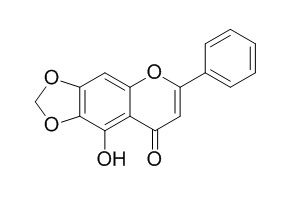Cochliophilin A
Cochliophilin A, host-specific plant signal, triggers a dynamic polymerization/depolymerization of F-actin in pathogenic A. cochlioides zoospores during early events of plant-peronosporomycete interactions. Cochliophilin A elicites attractant activity against the zoospores of the phytopathogenic Aphanomyces cochlioides.
Inquire / Order:
manager@chemfaces.com
Technical Inquiries:
service@chemfaces.com
Tel:
+86-27-84237783
Fax:
+86-27-84254680
Address:
1 Building, No. 83, CheCheng Rd., Wuhan Economic and Technological Development Zone, Wuhan, Hubei 430056, PRC
Providing storage is as stated on the product vial and the vial is kept tightly sealed, the product can be stored for up to
24 months(2-8C).
Wherever possible, you should prepare and use solutions on the same day. However, if you need to make up stock solutions in advance, we recommend that you store the solution as aliquots in tightly sealed vials at -20C. Generally, these will be useable for up to two weeks. Before use, and prior to opening the vial we recommend that you allow your product to equilibrate to room temperature for at least 1 hour.
Need more advice on solubility, usage and handling? Please email to: service@chemfaces.com
The packaging of the product may have turned upside down during transportation, resulting in the natural compounds adhering to the neck or cap of the vial. take the vial out of its packaging and gently shake to let the compounds fall to the bottom of the vial. for liquid products, centrifuge at 200-500 RPM to gather the liquid at the bottom of the vial. try to avoid loss or contamination during handling.
Anticancer Agents Med Chem.2023, 23(10):1204-1210.
J Integr Plant Biol.2023, 13564.
Preprints2022, 202211.0388.v1.
Molecules.2023, 28(19):6767.
Food Chem.2018, 252:207-214
AMB Express2020. 10(1):126.
J Ethnopharmacol.2024, 335:118628.
Adv Healthc Mater.2024, 13(13):e2303276.
Progress In Microbes & Molecular Biology2025, 8,1:a0000470.
Evid Based Complement Alternat Med.2018, 2018:3610494
Related and Featured Products
Z Naturforsch C. 2009 Nov-Dec;64(11-12):847-52.
Variation in chemotactic preferences of Aphanomyces cochlioides zoospores to flavonoids.[Pubmed:
20158156]
The zoospores of the phytopathogenic Aphanomyces cochlioides are chemotactically attracted by a host-specific flavone, Cochliophilin A (5-hydroxy-6,7-methylenedioxyflavone), and repelled from the mammalian estrogens or estrogenic compounds. This study further examined the responses of A. cochlioides zoospores to some flavonoids structurally related to Cochliophilin A or compounds known as phytoestrogens.
METHODS AND RESULTS:
The bioassay revealed that some synthetic flavones (such as 6-methyl-4'-methoxyflavone, 3-hydroxy-4'-methoxyflavone, 7-hydroxy-5-methylflavone, 3-hydroxy-4'-methoxy-6-methylflavone) elicited attractant activity at concentrations as low as picomolar (10 pM), which was an 100-fold lower concentration than that of the threshold concentration of the host-specific attractant Cochliophilin A. Apparently, a hydrophobic B-ring with an alkylated (methylated) A-ring or a methoxylated B-ring with an unsubstituted A-ring in the flavone skeleton played a significant role in higher attractant activity. On the other hand, all known estrogenic flavonoids (such as equol, 3'- or 8-prenylated naringenins) displayed potent repellent activity toward zoospores.
CONCLUSIONS:
Surprisingly, zoospores were attracted by non-estrogenic 6-prenylated naringenin indicating that repellent activity is linked to the estrogenic activity of the phytoestrogens.
Cell Motil Cytoskeleton. 2008 Jul;65(7):553-62.
Dynamic rearrangement of F-actin organization triggered by host-specific plant signal is linked to morphogenesis of Aphanomyces cochlioides zoospores.[Pubmed:
18412254]
Cochliophilin A (5-hydroxy-6,7-methylenedioxyflavone), a root releasing host-specific plant signal triggers chemotaxis and subsequent morphological changes in pathogenic Aphanomyces cochlioides zoospores before host penetration.
METHODS AND RESULTS:
The present study illustrates time-course changing patterns of cytoskeletal filamentous actin (F-actin) organization in the zoospores of A. cochlioides during rapid morphological changes (encystment and germination) after exposure to Cochliophilin A. Confocal laser scanning microscopic analysis revealed that F-actin microfilaments remained concentrated at ventral groove and diffusely distributed in peripheral cytoplasm of the zoospore. These microfilaments dramatically rearranged and changed into granular F-actin plaques interconnected with fine arrays during encystment. A large patch of actin arrays accumulated at one pole of the cystospores just before germination. Then the actin plaques moved to the emerging germ tube where a distinct cap of microfilaments was seen at the tip of the emerging hypha. Zoospores treated with an inhibitor of F-actin polymerization, latrunculin B or motility halting and regeneration inducing compound nicotinamide, displayed different patterns of F-actin in both zoospores and cystospores than those obtained by the induction of Cochliophilin A.
CONCLUSIONS:
Collectively, these results indicate that the host-specific plant signal Cochliophilin A triggers a dynamic polymerization/depolymerization of F-actin in pathogenic A. cochlioides zoospores during early events of plant-peronosporomycete interactions.
Arch Biochem Biophys. 2004 Dec 15;432(2):145-51.
A photoaffinity probe designed for host-specific signal flavonoid receptors in phytopathogenic Peronosporomycete zoospores of Aphanomyces cochlioides.[Pubmed:
15542053]
Aphanomyces cochlioides zoospores show chemotaxis to Cochliophilin A (5-hydroxy-6,7-methylenedioxyflavone, 1), a host derived attractant, and also respond to 5,7-dihydroxyflavone (2) known as an equivalent chemoattractant.
METHODS AND RESULTS:
To investigate the chemotactic receptors in the zoospores, we designed photoaffinity probes 4'-azido-5,7-dihydroxyflavone (3) and 4'-azido-7-O-biotinyl-5-hydroxyflavone (4) considering chemical structure of 2. Both 3 and 4 had zoospore attractant activity which was competitive with that of 1. When zoospores were treated with the biotinylated photoaffinity probe followed by UV irradiation and streptavidin-gold or peroxidase-conjugated streptavidin, probe-labeled proteins were detected on the cell membrane.
CONCLUSIONS:
This result indicated that the 1-specific-binding proteins, a candidate for hypothetical Cochliophilin A receptor, were localized on the cell membrane of the zoospores.
This is the first experimental evidence of flavonoid-binding proteins being present in zoospores, using chemically synthesized azidoflavone as photoaffinity-labeling reagent.



